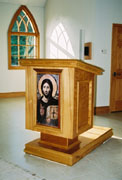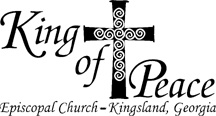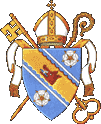Christ Sinai
 The pulpit at King of Peace features an icon referred to either as Christ Pantocrator, meaning Christ the Judge of All, or Christ Sinai, as it was found at St. Catherine's Monastery at the base of Mount Sinai in Egypt. Originally dated to the 13th century, the icon was cleaned and redated in 1962 to reveal that it is perhaps the oldest icon of Christ in existence, dating from about 590. The icon also seems to have served as the model for many other paintings of Christ, which also share its proportions.
The pulpit at King of Peace features an icon referred to either as Christ Pantocrator, meaning Christ the Judge of All, or Christ Sinai, as it was found at St. Catherine's Monastery at the base of Mount Sinai in Egypt. Originally dated to the 13th century, the icon was cleaned and redated in 1962 to reveal that it is perhaps the oldest icon of Christ in existence, dating from about 590. The icon also seems to have served as the model for many other paintings of Christ, which also share its proportions. In keeping with Jewish theology which spoke of the right hand of God as love and the left hand as justice, this icon shows Christ making a sign of blessing with his right hand, while holding the Gospel book in his left. The eyes are also asymmetrical, which some connect to one eye looking on in judgment, seeing all, while the other looks on in love. Another possible reason for the icon's particular way of portraying Jesus comes from an interesting source. It has been noted that the icon also shares its proportions with the Shroud of Turin which may have served as a source for the icon. A French researcher points to 15 major shared features between the Shroud and the icon, while a detailed analysis points to 170 "points of congruence" between the images.
In keeping with Jewish theology which spoke of the right hand of God as love and the left hand as justice, this icon shows Christ making a sign of blessing with his right hand, while holding the Gospel book in his left. The eyes are also asymmetrical, which some connect to one eye looking on in judgment, seeing all, while the other looks on in love. Another possible reason for the icon's particular way of portraying Jesus comes from an interesting source. It has been noted that the icon also shares its proportions with the Shroud of Turin which may have served as a source for the icon. A French researcher points to 15 major shared features between the Shroud and the icon, while a detailed analysis points to 170 "points of congruence" between the images.While we would never worship any image, including any image of Jesus, it is not inappropriate to have in worship a reproduction of one of the oldest and most influential portrayals of Jesus ever made. We are grateful to parishioner Scott Landry, who created our one-of-a-kind pulpit.







2 Comments:
At 8/25/2011 11:47 AM, Ed said…
Ed said…
Nice looking pulpit.
At 8/25/2011 11:59 AM, Ed said…
Ed said…
By the way, it is thought by many that the Christological controversies raging in those centuries could have much to do with the asymmetry. The right side of the face shows a divine serenity, while the left shows a very human emotional enlivenment. Perhaps He's about to crack a smile. You have the human and divine in perfect union in the one person of Christ. This is ultimately what icons are all about--the incarnation.
Post a Comment
<< Home